CeraVe and La Roche-Posay are two of the most popular drugstore skincare brands on the market, each with a loyal following of fans.
While both brands offer a range of high-quality products, they have different approaches to skincare and may be better suited for different skin types and concerns.
In this blog post, we’ll take a closer look at CeraVe vs La Roche-Posay, comparing the key ingredients and benefits of several products to help you decide which brand is right for you.

This post contains affiliate links, and any purchases made through these links will result in a commission for me at no extra cost to you. Please read my Disclosure for additional information.
Cerave vs La Roche-Posay
If you live in the US, as I do, then you have probably seen CeraVe in the skincare aisle of your local drugstore or retailer. La Roche-Posay may not be on your radar as much since it is a French pharmacy brand.
Both brands are committed to providing optimized skincare solutions for all skin types.
CeraVe is excellent for those with dry skin, as the ceramides in their products help lock in moisture and provide a protective barrier.
CeraVe’s MVE delivery system helps to ensure that the key ingredients are released slowly over time, providing a more even absorption and extended hydration.
Meanwhile, many La Roche-Posay products are ideal for those with a sensitive skin type, as their proprietary thermal spring water helps soothe inflammation and protect the skin.
La Roche-Posay is more expensive than CeraVe but offers quality and effectiveness.
Let’s take a look at several products that I’ve tested from both brands, ranging from cleansers and serums to face and body moisturizers:
CeraVe Hydrating Facial Cleanser vs La Roche-Posay Toleriane Hydrating Gentle Cleanser
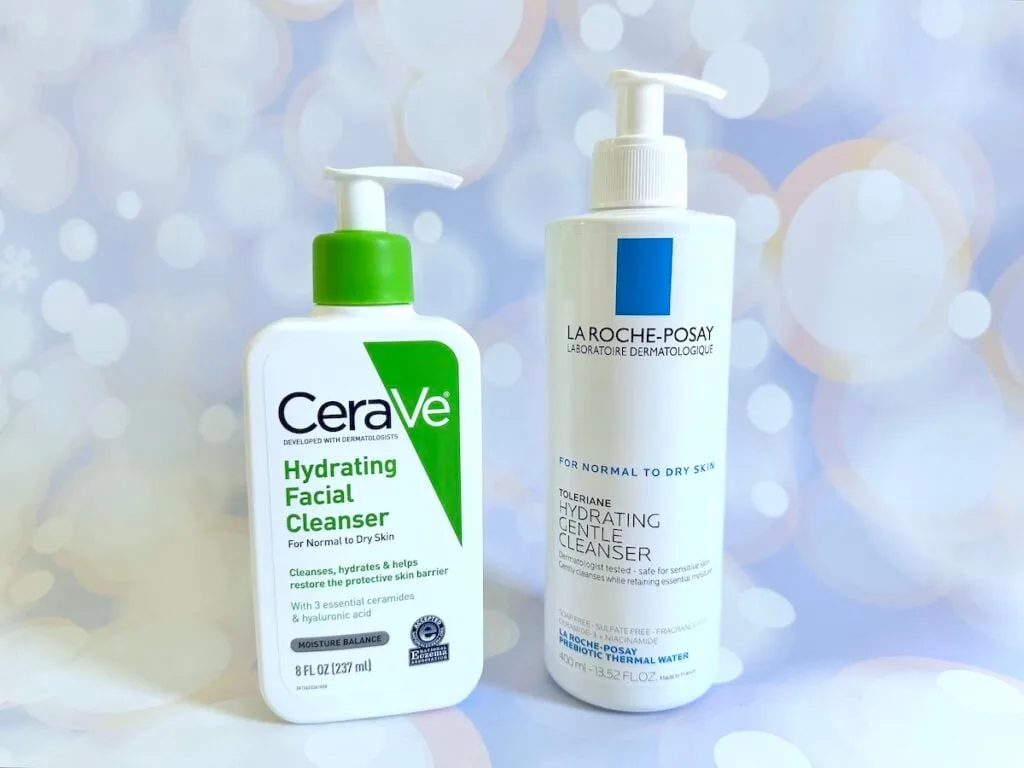
CeraVe Hydrating Facial Cleanser
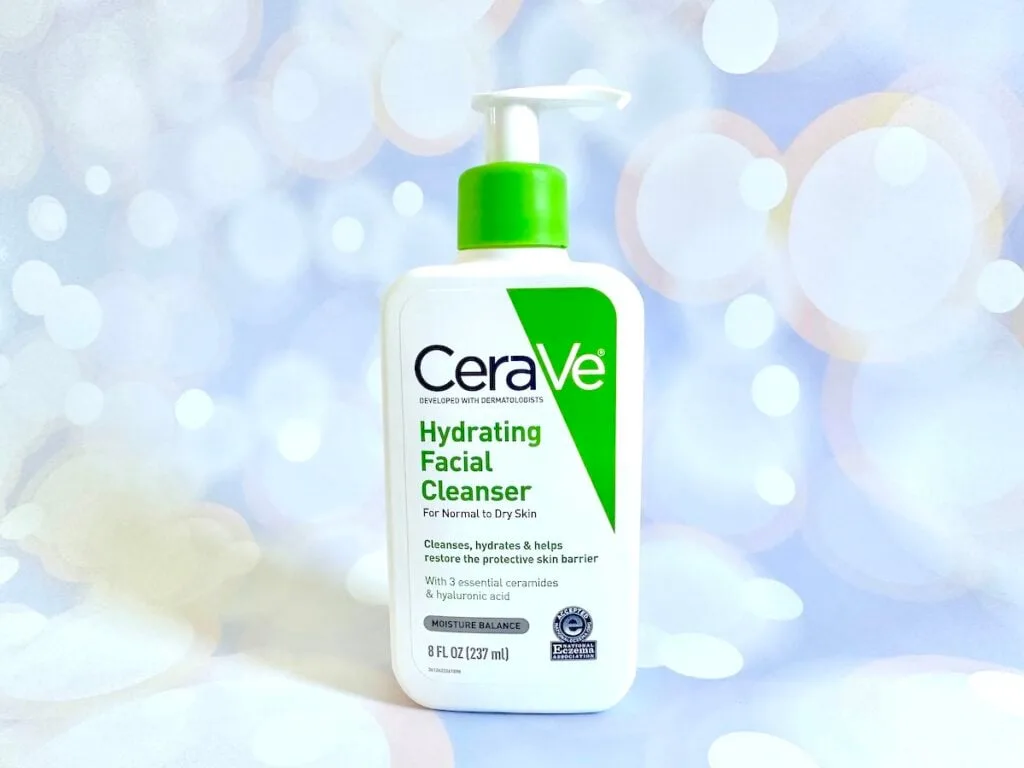
CeraVe Hydrating Facial Cleanser, formulated for normal to dry skin, is a hydrating face wash that gently removes makeup, dirt, and oil.
The hydrating cleanser is formulated with three essential ceramides that help to restore and maintain your skin’s natural barrier.
The cleanser also contains hyaluronic acid (in the salt form of sodium hyaluronate) to help draw moisture to the skin and keep it hydrated.
Moisturizing glycerin and cholesterol are also included in the cleanser to help reinforce the skin’s barrier. Tocopherol (vitamin E) helps protect your skin from environmental pollutants.
MVE Technology encapsulates and releases ingredients over time for long-lasting effects.
The cleanser is also accepted by the National Eczema Association.
The gentle non-foaming gel-cream cleanser is non-irritating, fragrance-free, and non-comedogenic, so it won’t clog pores or cause acne and breakouts.
La Roche-Posay Toleriane Hydrating Gentle Cleanser
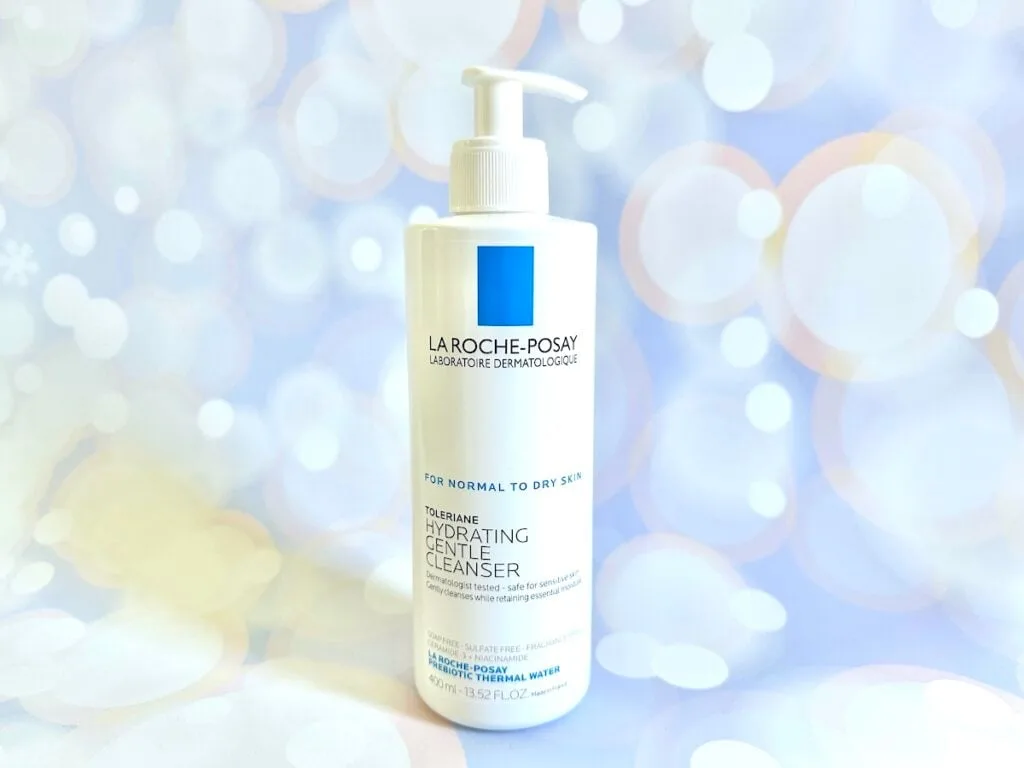
La Roche-Posay Toleriane Hydrating Gentle Cleanser, formulated for normal to dry, sensitive skin, contains soothing actives that gently cleanse your skin of makeup, dirt, and other impurities.
This gentle face wash contains La Roche-Posay Prebiotic Thermal Water and ceramide-3 to nourish dry skin and support a healthy skin barrier. Ceramide-3 helps maintain your skin’s pH for a balanced complexion.
Niacinamide, also known as vitamin B3, helps to reduce redness and soothe the skin. Niacinamide also balances oil production and helps brighten dull, uneven skin tone.
This cleanser is fragrance-free, soap-free, sulfate-free, paraben-free, oil-free, and non-comedogenic, so it won’t clog your pores.
The cream formula hydrates and moisturizes, leaving your skin soft and smooth, never dry or tight.
CeraVe vs La Roche-Posay Cleanser (Non-Foaming) Similarities & Differences

| Similarities | Differences |
|---|---|
| ✅ Non-foaming | ✅ CeraVe contains two additional ceramides, cholesterol and vitamin E |
| ✅ Contain glycerin and ceramide-3 | ✅ La Roche-Posay contains niacinamide and La Roche-Posay Prebiotic Thermal Water |
| ✅ Fragrance-free | ✅ CeraVe is accepted by the National Eczema Association |
| ✅ Non-comedogenic | |
| ✅ Suitable for sensitive skin |
Both cleansers are fragrance-free, non-foaming, and gentle on the skin, making them suitable for sensitive skin types.
They both contain glycerin and ceramide-3 (ceramide NP) to nourish and hydrate the skin and help restore its natural protective barrier.
CeraVe contains additional ceramides, cholesterol, and vitamin E, while La Roche-Posay contains niacinamide and La Roche-Posay Prebiotic Thermal Water.
CeraVe is accepted by the National Eczema Association.
CeraVe Foaming Facial Cleanser vs La Roche-Posay Toleriane Purifying Foaming Facial Cleanser
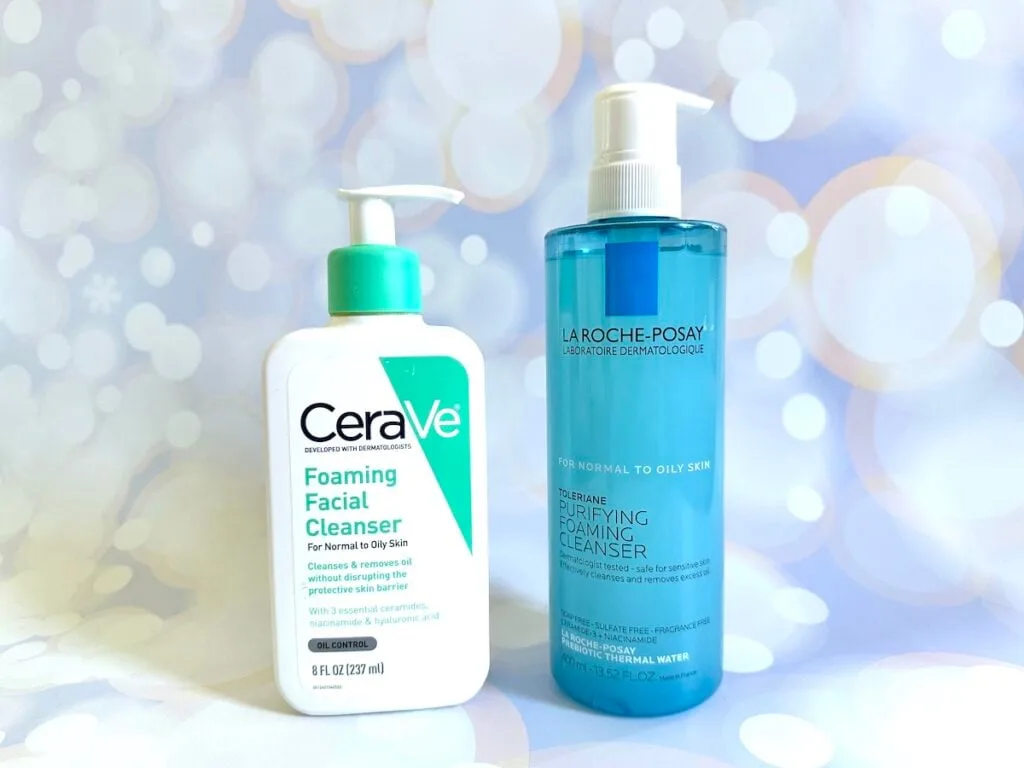
CeraVe Foaming Facial Cleanser
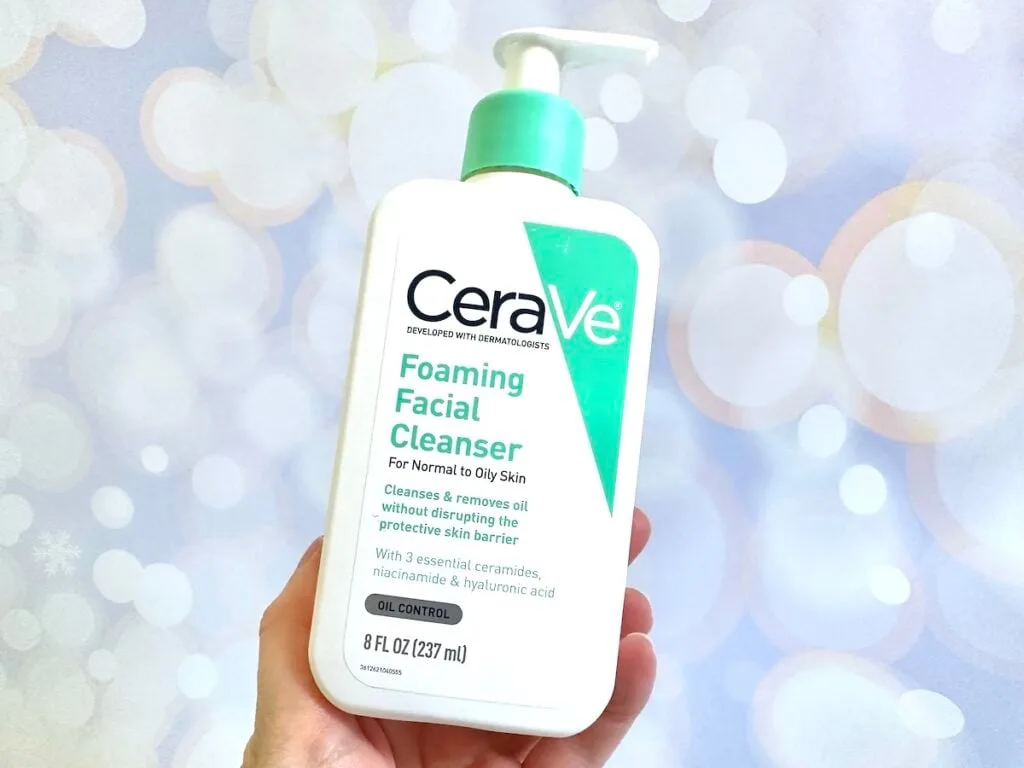
CeraVe Foaming Facial Cleanser, formulated for normal to oily skin, is a foaming face wash that deeply cleanses your skin and removes dirt, makeup, and oil while supporting a healthy skin barrier.
The cleanser contains CeraVe’s three essential ceramides (Ceramide NP, Ceramide AP, Ceramide EOP), which are lipids that help to replenish and lock in moisture while maintaining your skin’s protective moisture barrier.
Think of ceramides as the glue that holds skin cells together. Decreased ceramide levels have been linked to skin conditions like atopic dermatitis and psoriasis, so replenishing ceramides are key for keeping your skin hydrated.
The foam cleanser also contains hyaluronic acid in its salt form of sodium hyaluronate to attract and hold moisture in the skin.
Cholesterol is another lipid included in the cleanser to help support the skin’s moisture levels.
Niacinamide, also known as vitamin B3, is a skin-restoring ingredient that helps to reduce redness and soothe the skin while balancing sebum (oil) production and reducing the look of pores.
Niacinamide also helps even out uneven skin tone and brightens dull skin.
Like CeraVe’s other products, this cleanser uses CeraVe’s proprietary MVE technology that releases ingredients slowly over time for all-day hydration.
This foaming face wash is fragrance-free, suitable for sensitive skin, and non-comedogenic, so you don’t have to worry about it clogging your pores.
NOTE: If you have oily or acne-prone skin, CeraVe offers additional cleansers formulated for your skin type:
La Roche-Posay Toleriane Purifying Foaming Facial Cleanser
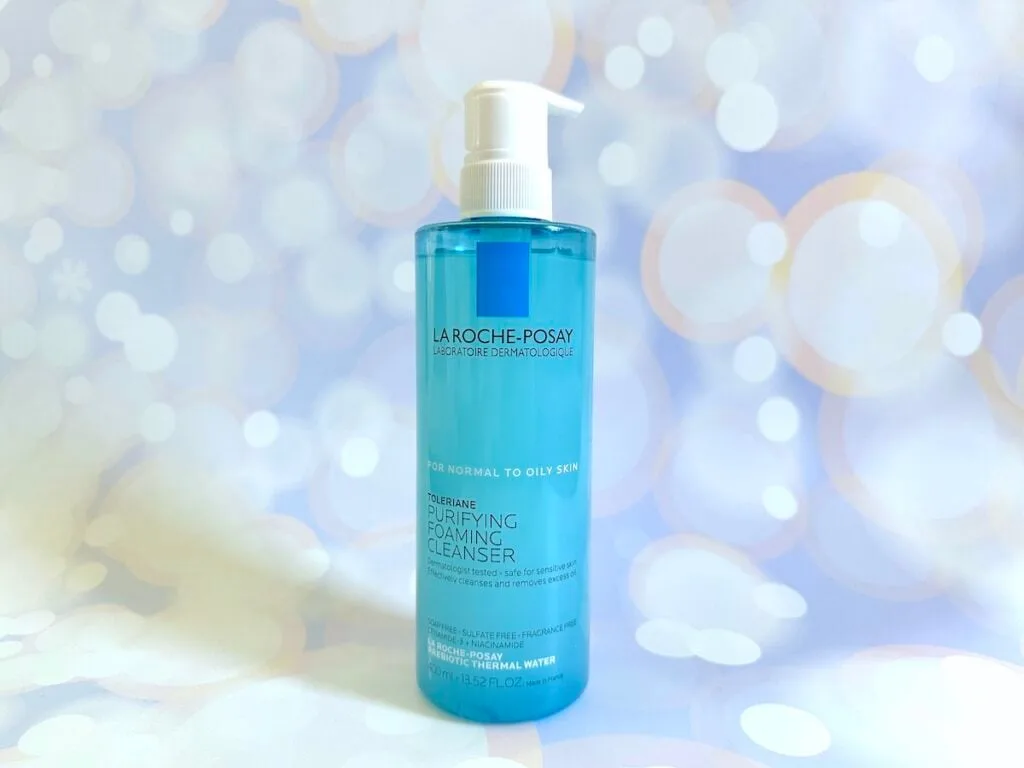
La Roche-Posay Toleriane Purifying Foaming Facial Cleanser, formulated for normal to oily, sensitive skin, is a gentle face wash that removes dirt, makeup, oil, and other impurities while protecting your skin’s pH and moisture barrier.
The cleanser contains ceramide NP, like CeraVe, to support a healthy skin barrier. This skin-identical lipid helps protect the skin from environmental aggressors and retain moisture by forming a protective barrier on the skin’s surface.
The cleanser also contains La Roche-Posay Prebiotic Thermal Water, a mineral and antioxidant-rich spring water that helps soothe and protect the skin from environmental aggressors.
Niacinamide, an anti-inflammatory and brightening vitamin that helps fade hyperpigmentation and dark spots, also helps boost collagen production for firmer skin.
This face wash is fragrance-free, oil-free, non-comedogenic, soap-free, paraben-free, and soap-free. It is also suitable for sensitive skin.
You only need a small amount to get a rich, creamy lather.
Like CeraVe, La Roche-Posay offers additional cleansers for oily, acne-prone skin:
- Effaclar Medicated Acne Face Wash
- Effaclar Gel Face Wash For Oily Skin
- Effaclar Cream Cleanser For Oily Skin
CeraVe vs La Roche-Posay Cleanser (Foaming) Similarities & Differences
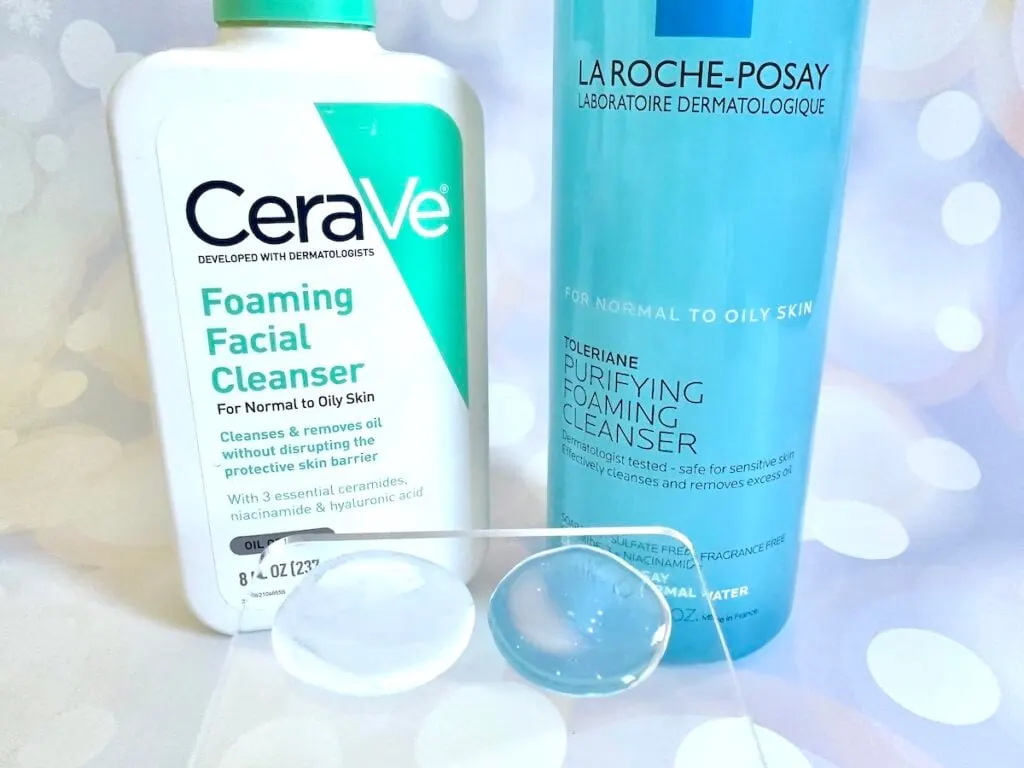
| Similarities | Differences |
|---|---|
| ✅ Foaming gel cleansers | ✅ CeraVe contains two additional ceramides, hyaluronic acid, and cholesterol |
| ✅ Contain ceramide NP and niacinamide | ✅ La Roche-Posay contains La Roche-Posay Prebiotic Thermal Water |
| ✅ Fragrance-free and non-comedogenic | |
| ✅ Suitable for sensitive skin |
Both cleansers are a gel texture and are foaming, fragrance-free, and non-comedogenic. They are both suitable for sensitive skin.
Both contain ceramide NP and niacinamide to replenish the skin and protect the skin’s moisture barrier.
CeraVe contains two additional ceramides, cholesterol and hyaluronic acid, while La Roche-Posay contains La Roche-Posay Prebiotic Thermal Water.
CeraVe Hyaluronic Acid Serum vs La Roche-Posay Hyalu B5 Pure Hyaluronic Acid Serum
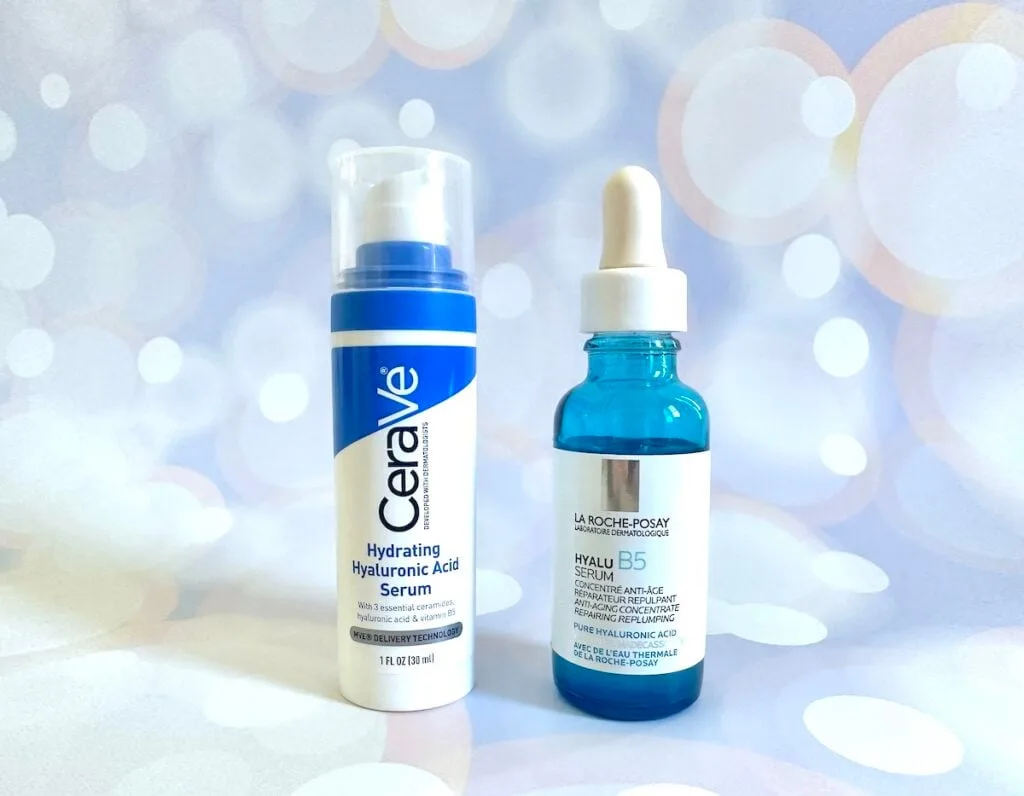
CeraVe Hyaluronic Acid Serum

Cerave Hyaluronic Acid Serum is a gel-cream serum formulated with hyaluronic acid in the salt form of sodium hyaluronate.
Compared to hyaluronic acid, sodium hyaluronate has a smaller molecular size and can be absorbed deeper into the skin.
This serum also contains three essential ceramides (ceramide NP, ceramide AP, and ceramide EOP), which are moisturizing lipids that support a healthy skin barrier.
Glycerin acts as a humectant to attract moisture, while pro-vitamin B5 (panthenol) soothes and calms the skin and helps it retain moisture.
The serum also contains CeraVe’s proprietary MVE Technology, which helps release moisturizing ingredients slowly for extended hydration.
The serum is non-comedogenic, so it won’t clog pores and is fragrance-free and paraben-free.
The thick serum almost feels like a moisturizing lotion. It absorbs quickly and leaves the skin soft, smooth, and hydrated.
La Roche-Posay Hyalu B5 Pure Hyaluronic Acid Serum

La Roche-Posay Hyalu B5 Pure Hyaluronic Acid Serum is formulated with hyaluronic acid to hydrate your skin and replenish lost moisture.
This serum is perfect for you if you deal with the signs of aging, like fine lines and loss of skin elasticity and volume.
The hyaluronic serum contains two forms of hyaluronic acid: sodium hyaluronate and hydrolyzed hyaluronic acid, which has been broken down into smaller molecules.
Sodium hyaluronate has a low molecular weight and can penetrate deeper into the skin to deliver more intense hydration, while hydrolyzed hyaluronic acid helps to bind moisture to the skin’s surface.
The serum also contains pro-vitamin B5 (panthenol) to help reduce inflammation and boost hydration levels. Glycerin is another humectant in the serum that helps keep your skin soft and smooth.
Madecassoside from the Centella asiatica plant soothes the skin and helps reduce redness and irritation. It also has wound-healing and antioxidant properties.
This rich serum absorbs quickly, has a noticeable fresh fragrance, and is suitable for all skin types, including sensitive skin.
CeraVe vs La Roche-Posay Hyaluronic Acid Similarities & Differences
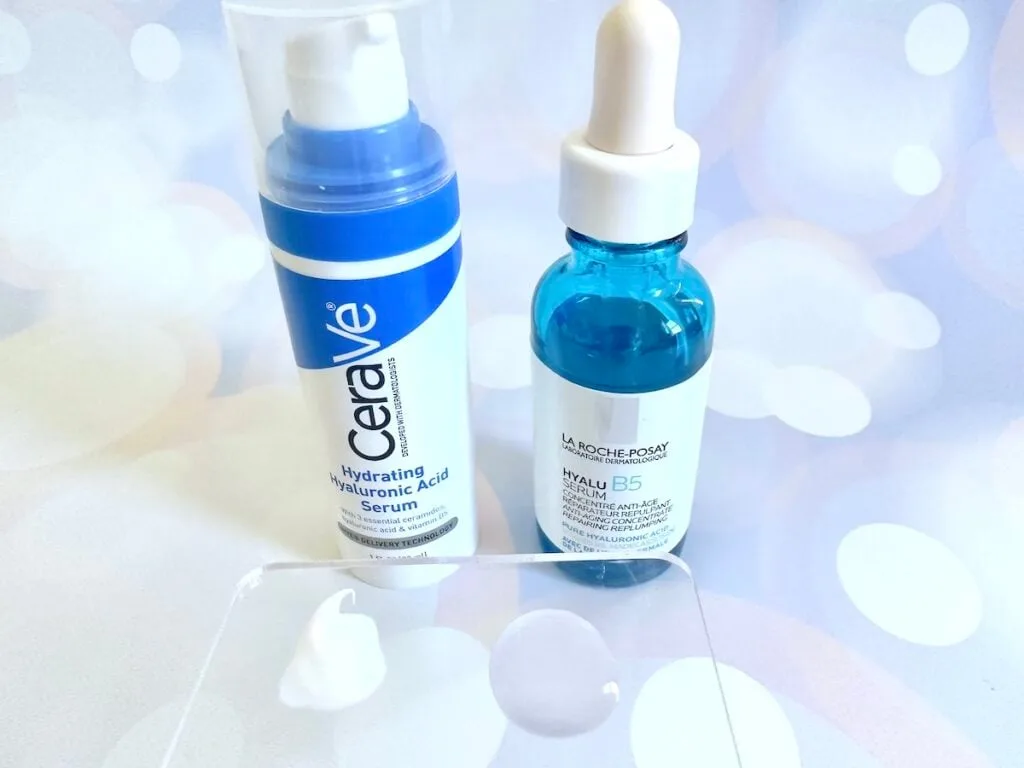
| Similarities | Differences |
|---|---|
| ✅ Contain sodium hyaluronate, glycerin, and panthenol | ✅ CeraVe => thicker gel-cream; La Roche-Posay => liquid gel |
| ✅ Non-comedogenic | ✅ CeraVe contains three essential ceramides |
| ✅ La Roche-Posay contains an additional form of hyaluronic acid and soothing madecassoside | |
| ✅ CeraVe is fragrance-free, La Roche-Posay is not | |
| ✅ La Roche-Posay is suitable for sensitive skin |
Both contain glycerin, panthenol, and sodium hyaluronate and are non-comedogenic.
CeraVe’s hyaluronic acid serum has a thicker gel-cream texture, while la Roche-Posay Hyalu serum has a liquid gel texture.
CeraVe contains three essential ceramides for skin barrier support.
La Roche-Posay contains an additional form of hyaluronic acid (hydrolyzed hyaluronic acid) and soothing and anti-inflammatory madecassoside.
CeraVe is fragrance-free, while La-Roche Posay contains a noticeable fragrance.
La Roche-Posay is suitable for sensitive skin.
Related Post: La Roche Posay Hyalu B5 Serum vs The Ordinary Hyaluronic Acid
CeraVe Skin Renewing Vitamin C Serum vs La Roche-Posay Pure Vitamin C10 Serum

CeraVe Skin Renewing Vitamin C Serum

CeraVe Skin Renewing Vitamin C Serum is formulated with 10% pure l-ascorbic acid (pure vitamin C), three essential ceramides, hyaluronic acid in its salt form of sodium hyaluronate, plus vitamin B5.
Vitamin C provides many skin benefits, like antioxidant protection from UV rays (sun damage) and environmental factors like pollution. It also helps brighten the skin and support an even skin tone while reducing hyperpigmentation and dark spots.
Three essential ceramides (ceramide NP, ceramide AP, and ceramide EOP) strengthen and restore the skin’s natural moisture barrier.
Glycerin moisturizes, and pro-vitamin B5, also called panthenol, helps reduce inflammation and soothe the skin.
The serum also contains CeraVe’s proprietary MVE Technology that delivers key ingredients over time for extended hydration for up to 24 hours.
It has a light, silky and non-greasy feel that absorbs quickly without leaving any residue. It works well when applied under makeup, too.
This CeraVe vitamin C serum is fragrance-free, paraben-free, is non-comedogenic, so it won’t clog your pores or cause breakouts. Also, it comes in packaging that helps protect against oxidation.
La Roche-Posay Pure Vitamin C10 Serum

La Roche-Posay Pure Vitamin C10 Serum is an anti-aging serum formulated to smooth wrinkles and fine lines and improve skin texture, tone, and radiance.
The serum contains a 10% concentration of pure vitamin C, also known as ascorbic acid or l-ascorbic acid.
Vitamin C is a powerful antioxidant that helps brighten and even out skin tone, reduces the appearance of fine lines and wrinkles, and stimulates collagen production for a firmer, more youthful-looking complexion.
The serum also contains salicylic acid, a beta-hydroxy acid (BHA) that exfoliates your skin, lifts away dead skin cells, and unclogs pores. It helps prevent acne, controls excess oil production, and refines the look of pores.
Salicylic acid also reduces the appearance of blackheads and whiteheads and has anti-inflammatory properties that soothe redness and irritation. It’s excellent for acne-prone and oily skin.
The serum also contains a synthetic dipeptide known for its calming effect and ability to soothe sensitive skin, reducing skin redness and irritation.
Two forms of hyaluronic acid (sodium hyaluronate and hydrolyzed hyaluronic acid) plus glycerin hydrate and moisturize your skin.
La Roche-Posay Thermal Spring Water, sourced from the town of La Roche-Posay in France, contains minerals, trace elements, and skin-protective antioxidants.
The serum is oil-free and non-comedogenic, and suitable for sensitive skin.
Read more about this serum in my La Roche-Posay Vitamin C Serum review post.
CeraVe vs La Roche-Posay Vitamin C Similarities & Differences
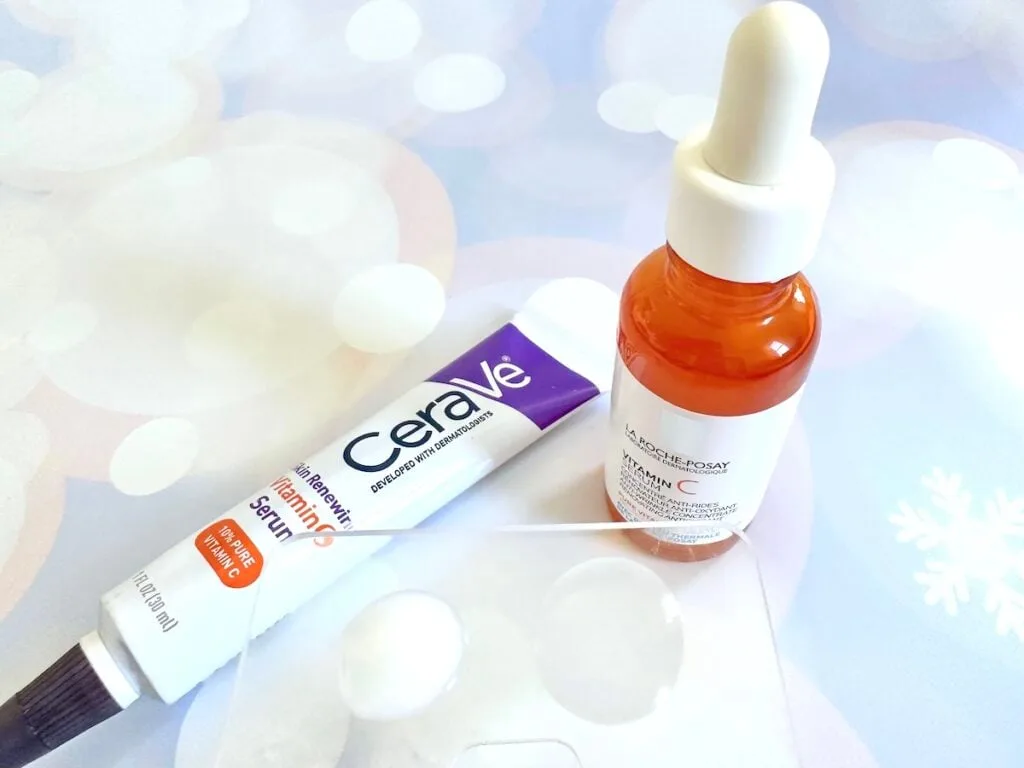
| Similarities | Differences |
|---|---|
| ✅ Contain 10% pure vitamin C, sodium hyaluronate, and glycerin | ✅ La Roche-Posay contains salicylic acid, an additional form of hyaluronic acid, and La Roche-Posay Thermal Spring Water |
| ✅ Non-comedogenic | ✅ CeraVe contains three essential ceramides, pro-vitamin B5 |
| ✅ La Roche-Posay is suitable for sensitive skin | |
| ✅ CeraVe is fragrance-free, La Roche-Posay is not |
Both serums contain a 10% concentration of ascorbic acid (pure vitamin C), sodium hyaluronate, and glycerin for hydration. La Roche-Posay also contains hydrolyzed hyaluronic acid.
CeraVe contains three essential ceramides and panthenol (pro-vitamin B5).
La Roche-Posay contains salicylic acid, making it a great choice for acne-prone skin. It also contains a soothing dipeptide and La Roche-Posay Thermal Spring Water.
Both are non-comedogenic. La Roche-Posay is suitable for sensitive skin.
CeraVe is fragrance-free, while La Roche-Posay contains fragrance.
CeraVe Skin Renewing Retinol Serum vs La Roche-Posay Retinol B3 Serum
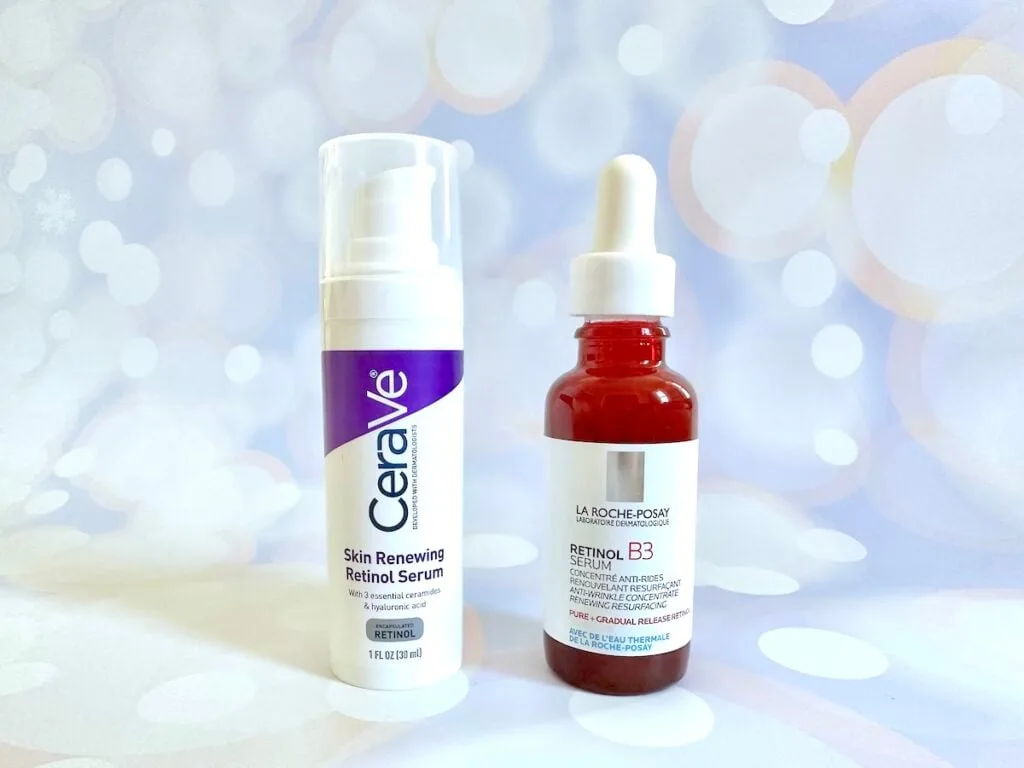
CeraVe Skin Renewing Retinol Serum

CeraVe Skin Renewing Retinol Serum is formulated to address the visible signs of aging, such as wrinkles and fine lines, and skin texture.
The serum contains encapsulated retinol, which is released slowly over time for maximum efficacy.
Retinol is a form of vitamin A that helps to reduce wrinkles, improve skin texture and tone, and minimize discoloration by boosting collagen production and increasing cell turnover for improved skin clarity.
Like other CeraVe products, this CeraVe retinol serum contains Ceramide NP, Ceramide AP, Ceramide EOP, and three essential ceramides that help restore the protective skin barrier.
Niacinamide brightens, calms redness and inflammation, and smoothes fine lines and wrinkles.
Cholesterol is a lipid and a key component of healthy skin that helps to restore the skin’s protective barrier and lock in moisture.
Hydrolyzed hyaluronic acid is a form of hyaluronic acid that is a little more easily absorbed than regular HA and helps hydrate the skin. Shea butter and glycerin moisturize and nourish the skin.
The serum contains CeraVe MVE Technology (MultiVesicular Emulsion technology). This patented delivery system helps deliver moisturizing ingredients slowly over time, so they can deeply penetrate the skin.
How Much Retinol Is In CeraVe Skin Renewing Retinol Serum?
Unfortunately, this CeraVe does not disclose the concentration of retinol in the serum.
From personal experience, I don’t think it’s a high concentration since it doesn’t irritate my somewhat sensitive skin. I think it’s a great starter retinol serum for beginners.
La Roche-Posay Retinol B3 Serum
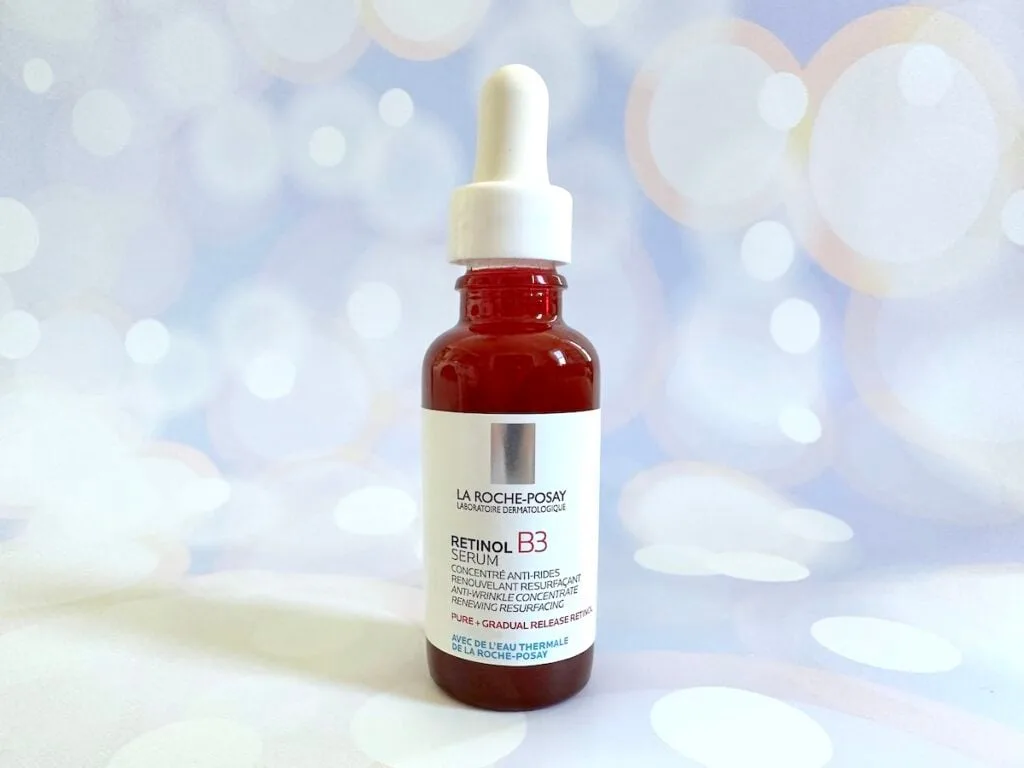
La Roche-Posay Retinol B3 Serum is an anti-aging face and neck serum that helps reduce the look of wrinkles, lines, and premature sun damage.
It pairs concentrated pure retinol with vitamin B3 (niacinamide) to tackle these signs of aging while also being suitable for sensitive skin.
The gradual release retinol in the formula helps boost cell turnover for improved radiance and a reduction in the look of wrinkles and fine lines.
Niacinamide (vitamin B3) helps balance the skin’s natural oil production, inhibits melanin (pigment) production for a brighter complexion, and supports a healthy skin barrier.
Hyaluronic acid (sodium hyaluronate) hydrates and plumps the skin while retaining moisture.
The serum also contains La Roche-Posay Thermal Spring Water, which contains minerals and antioxidants to help replenish the skin.
The serum is paraben-free, oil-free, and non-comedogenic (it won’t clog your pores).
Please note that there is added fragrance in this retinol serum.
How Much Retinol Is In La Roche-Posay Retinol B3 Serum?
Like CeraVe, La Roche-Posay doesn’t disclose the amount of retinol in the serum.
But since they note that the serum is suitable for sensitive skin, I don’t think the concentration is very high. I don’t notice any irritation when using this serum.
CeraVe vs La Roche-Posay Hyaluronic Retinol: Similarities & Differences
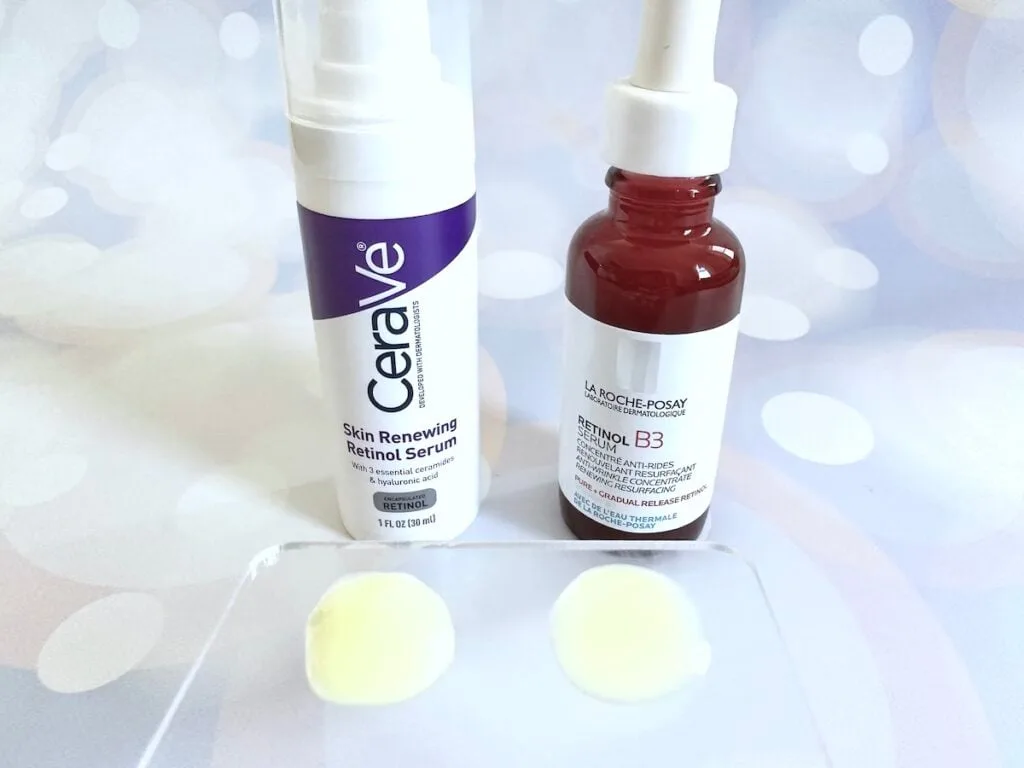
| Similarities | Differences |
|---|---|
| ✅ Contain gradual release retinol | ✅ CeraVe contains three essential ceramides, shea butter, and cholesterol |
| ✅ Neither serum discloses retinol concentration | ✅ La Roche-Posay contains La Roche-Posay Thermal Spring Water |
| ✅ Contain niacinamide, hyaluronic acid, and glycerin | ✅ La Roche-Posay is suitable for sensitive skin |
| ✅ Non-comedogenic | ✅ CeraVe is fragrance-free, La Roche-Posay is not |
Both serums contain gradual-release retinol and seem to contain low retinol concentrations, as neither brand disclose their concentrations.
Both are enriched with niacinamide, glycerin, and different forms of hyaluronic acid for hydration.
CeraVe contains three essential ceramides, shea butter, and moisturizing cholesterol, while La Roche-Posay contains La Roche-Posay Thermal Spring Water.
Both are non-comedogenic. La Roche-Posay is suitable for sensitive skin.
CeraVe is fragrance-free, while La Roche-Posay contains fragrance.
Related Post: A Complete Guide To Drugstore Retinol
CeraVe Daily Moisturizing Lotion vs La Roche-Posay Toleriane Double Repair Face Moisturizer
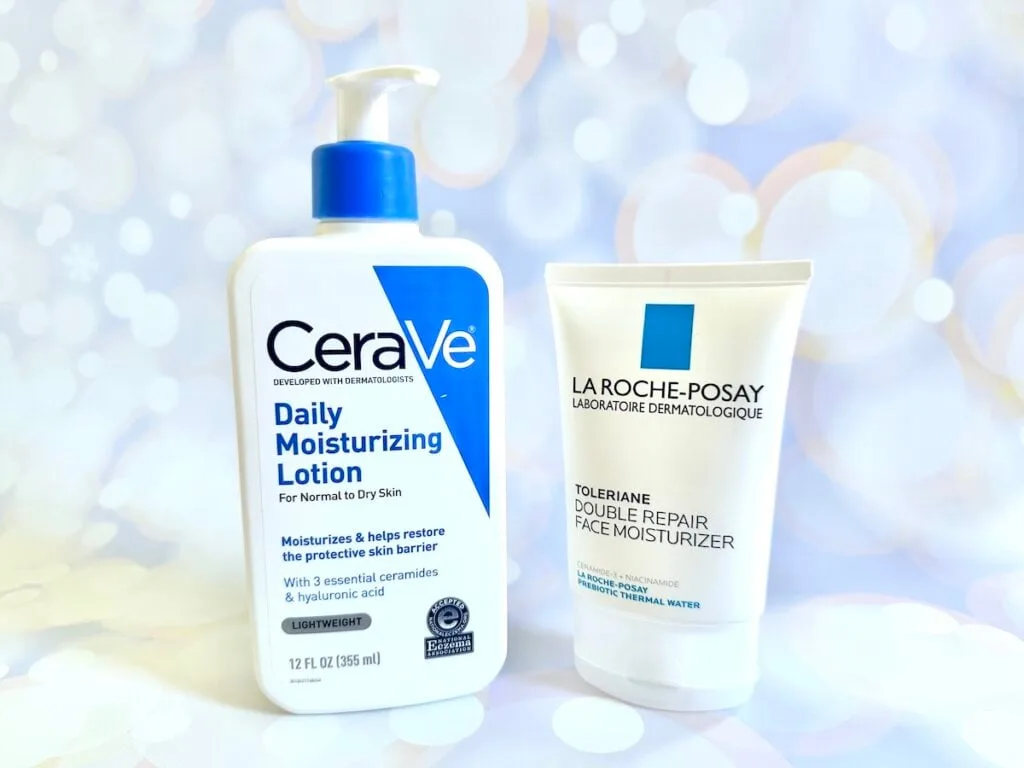
CeraVe Daily Moisturizing Lotion
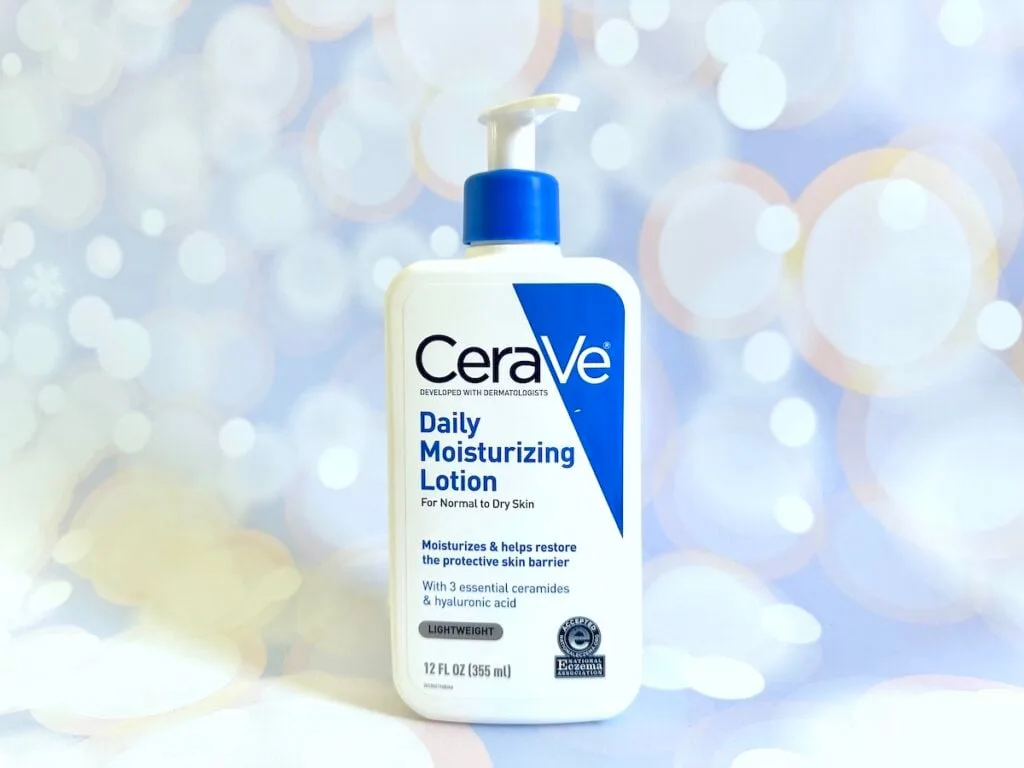
CeraVe Daily Moisturizing Lotion is a lightweight moisturizer formulated for normal to dry skin.
This silky lotion contains sodium hyaluronate (the better-absorbing salt form of hyaluronic acid) and three essential ceramides that work together to hydrate and restore the skin’s natural moisture barrier.
This oil-free moisturizer provides efficient and long-lasting hydration throughout the day from the encapsulated ceramides that are slowly released over time (CeraVe’s MVE Technology).
This lotion has been accepted by the National Eczema Association, making it a great choice for eczema-prone skin.
The moisturizer is fragrance-free, non-comedogenic, and fast-absorbing, providing 24-hour hydration without any greasiness.
One of the stand-out qualities of this lotion is that it can be used on both your face and body, making it a multi-use cost-effective skincare product.
La Roche-Posay Toleriane Double Repair Face Moisturizer
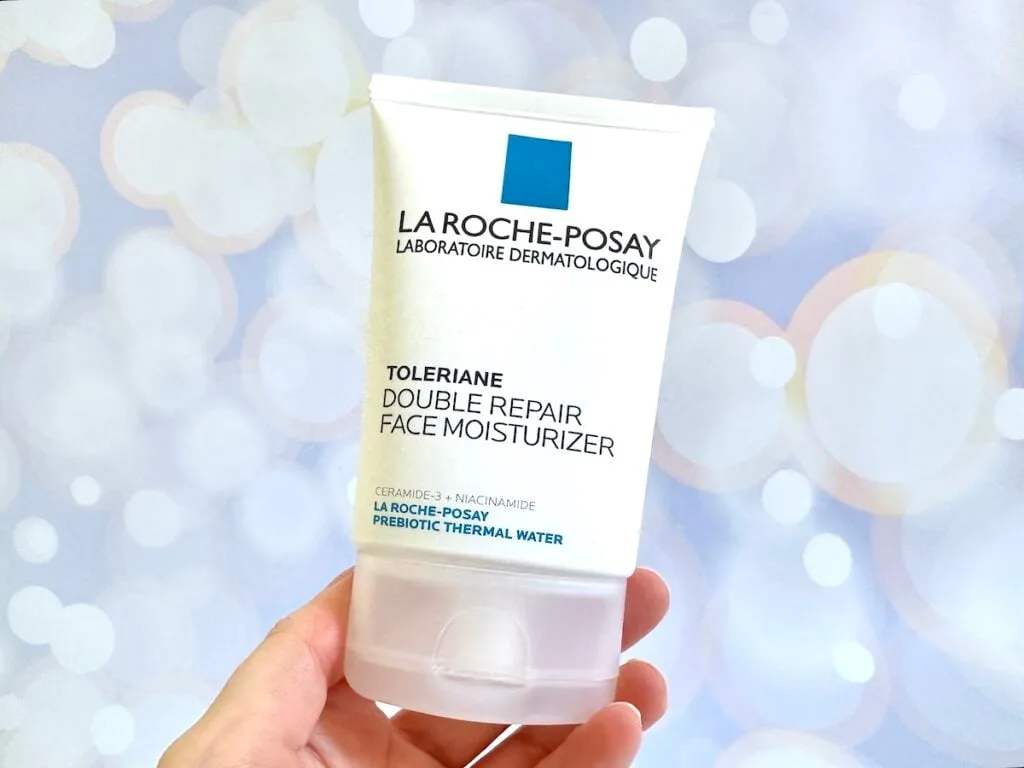
La Roche-Posay Toleriane Double Repair Face Moisturizer is a daily moisturizer that provides up to 48-hour hydration with its lightweight creamy texture.
Nourishing ingredients include ceramide-3 (ceramide NP), which helps repair and protect the skin’s natural moisture barrier, and niacinamide, which reduces the look of wrinkles and evens skin tone.
The moisturizer is also formulated with La Roche-Posay Prebiotic Thermal Water, a soothing water that helps to nourish skin with its minerals, trace elements, and antioxidants.
The moisturizer is suitable for all skin types, including sensitive skin. It’s fragrance-free, paraben-free, alcohol-free, oil-free, and non-comedogenic.
This is one of my favorite La Roche-Posay products, as it’s lightweight, hydrating, and provides long-lasting hydration. It’s non-greasy and wears well with makeup throughout the day.
CeraVe vs La Roche-Posay Lotion Moisturizers Similarities & Differences
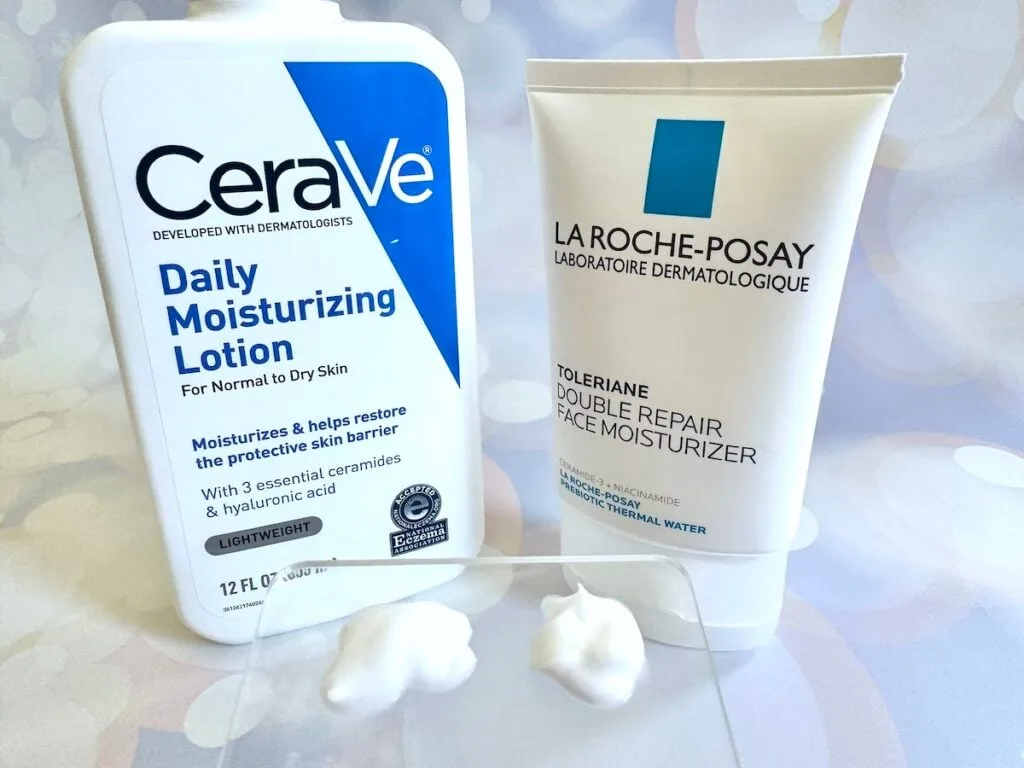
| Similarities | Differences |
|---|---|
| ✅ Contain ceramide-3 | ✅ La Roche-Posay has a richer texture |
| ✅ Non-comedogenic | ✅ CeraVe contains two additional ceramides |
| ✅ Fragrance-free | ✅ La Roche-Posay contains niacinamide and La Roche-Posay Prebiotic Thermal Water |
| ✅ Suitable for sensitive skin | ✅ CeraVe is accepted by the National Eczema Association |
| ✅ CeraVe can be used on both the face and body |
CeraVe lotion has a lightweight texture, while La Roche-Posay Double Repair has a richer texture.
Both moisturizers contain ceramide-3 (ceramide NP). CeraVe contains two additional ceramides, while La Roche-Posay contains niacinamide and La Roche-Posay Prebiotic Thermal Water.
Both are suitable for sensitive skin, fragrance-free, and non-comedogenic.
CeraVe is accepted by the National Eczema Association, making it suitable for eczema-prone skin.
CeraVe can be used on both the face and body, while La Roche-Posay is formulated specifically for the face.
CeraVe Moisturizing Cream vs La Roche-Posay Lipikar AP+M Triple Repair Moisturizing Body Cream
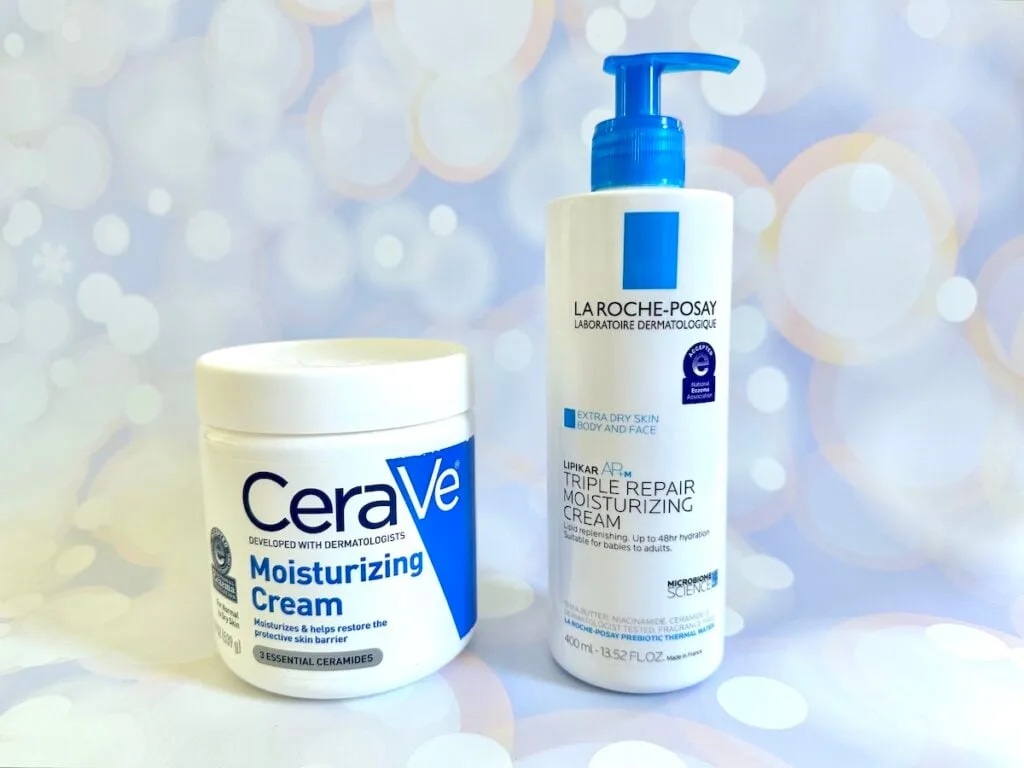
CeraVe Moisturizing Cream
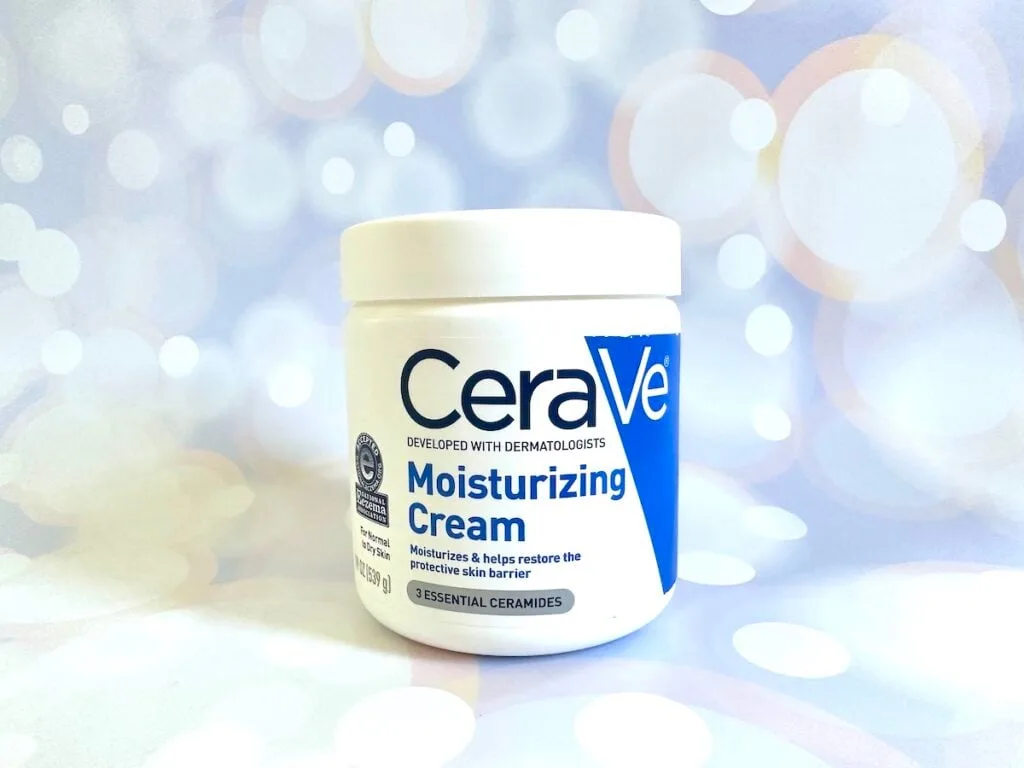
Cerave Moisturizing Cream is designed to nourish dry to very dry skin on both the face and body.
This CreaVe cream contains three essential ceramides that help replenish the skin’s natural moisture barrier and sodium hyaluronate for optimal hydration.
The cream is formulated with petrolatum, an occlusive ingredient that helps to lock in moisture and keep the skin hydrated.
The cream also contains cholesterol, a lipid naturally found in the skin that helps to strengthen the skin’s moisture barrier and protect it from external stressors.
This CeraVe cream is non-comedogenic and won’t clog pores or cause acne. It’s suitable for use on both the face and body.
Cerave Moisturizing Cream is accepted by the National Eczema Association and American Diabetes Association.
La Roche-Posay Lipikar AP+M Triple Repair Body Moisturizing Cream
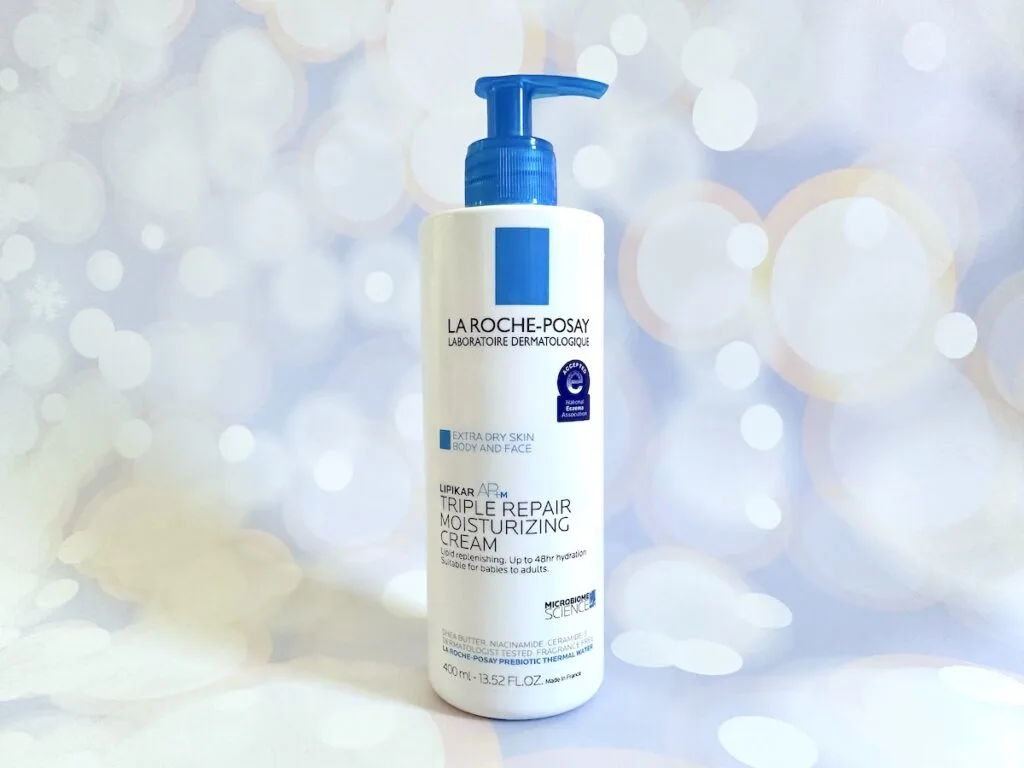
La Roche-Posay Lipikar AP+M Triple Repair Body Moisturizing Cream, formerly called Lipikar Balm AP+, is a body cream moisturizer formulated to reduce dry skin and provide up to 48 hours of hydration.
It’s triple action formula:
- Restores the skin barrier
- Replenishes skin lipids
- Balances the skin microbiome
This hydrating cream moisturizer contains shea butter that has been sustainably sourced in Burkina Faso, Africa. This nourishing ingredient moisturizes and softens the skin.
It also contains niacinamide to brighten and even out skin tone and ceramide-3 to repair and protect the skin’s natural moisture barrier.
Another soothing ingredient, La Roche-Posay Prebiotic Thermal Water, contains minerals, trace elements, and antioxidants that protect the skin.
Postbiotic Aqua Posae Filiformis (vitreoscilla filiformis) is a patented postbiotic that helps balance the skin’s microbiome, which can be disrupted when exposed to external aggressors.
This moisturizer is accepted by the National Eczema Association.
It is excellent for dry to extra dry skin and can be used on both your body and face. It’s also suitable for sensitive skin and babies 2 weeks and up.
CeraVe vs La Roche-Posay Cream Moisturizers Similarities & Differences
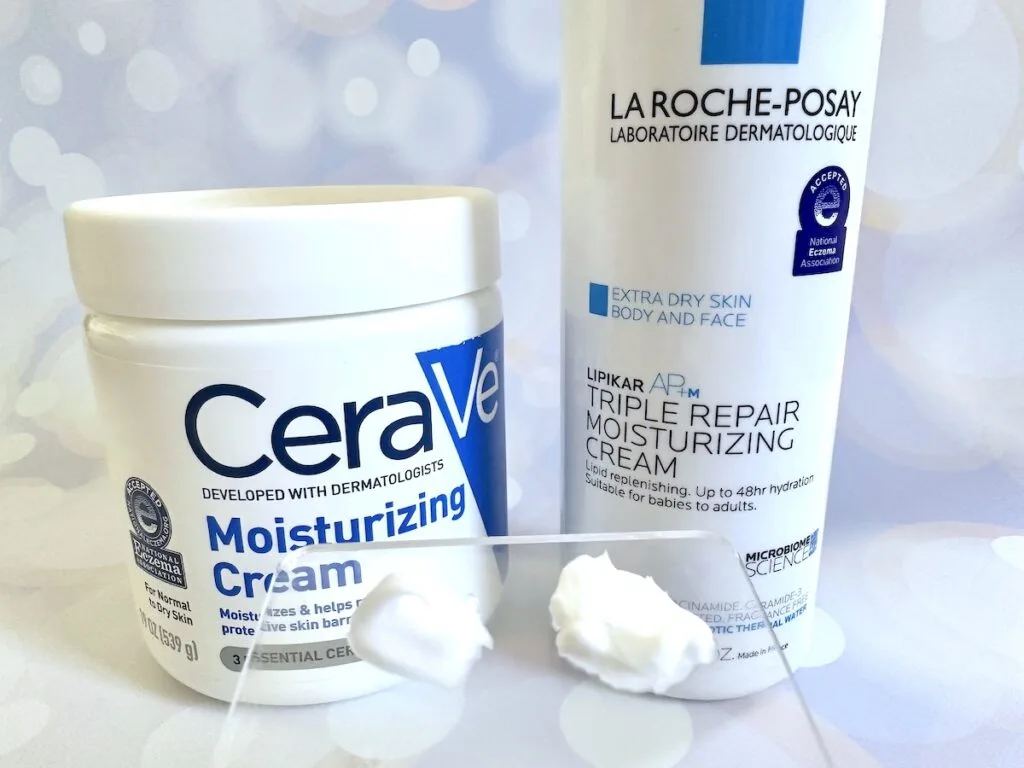
| Similarities | Differences |
|---|---|
| ✅ Ideal for dry to very dry skin | ✅ La Roche-Posay has a thicker, richer texture |
| ✅ Fragrance-free and non-comedogenic | ✅ CeraVe contains two additional ceramides, sodium hyaluronate, petrolatum, and cholesterol |
| ✅ Contain ceramide-3 | ✅ La Roche-Posay contains shea butter, niacinamide, La Roche-Posay Prebiotic Thermal Water + a postbiotic |
| ✅ Suitable for sensitive skin | ✅ CeraVe is accepted by the American Diabetes Association |
| ✅ Can be used on both the face and body | |
| ✅ Accepted by the National Eczema Association |
Both are suitable for sensitive skin, non-comedogenic, and fragrance-free.
CeraVe contains three essential ceramides, petrolatum, and cholesterol.
La Roche-Posay contains shea butter, niacinamide, La Roche-Posay Prebiotic Thermal Water, and a postbiotic to help balance the skin’s microbiome.
Both creams can be used on the face and body.
Both are accepted by the National Eczema Association.
CeraVe Moisturizing Cream is also accepted by American Diabetes Association.
CeraVe Healing Ointment vs La Roche-Posay Cicaplast Balm B5
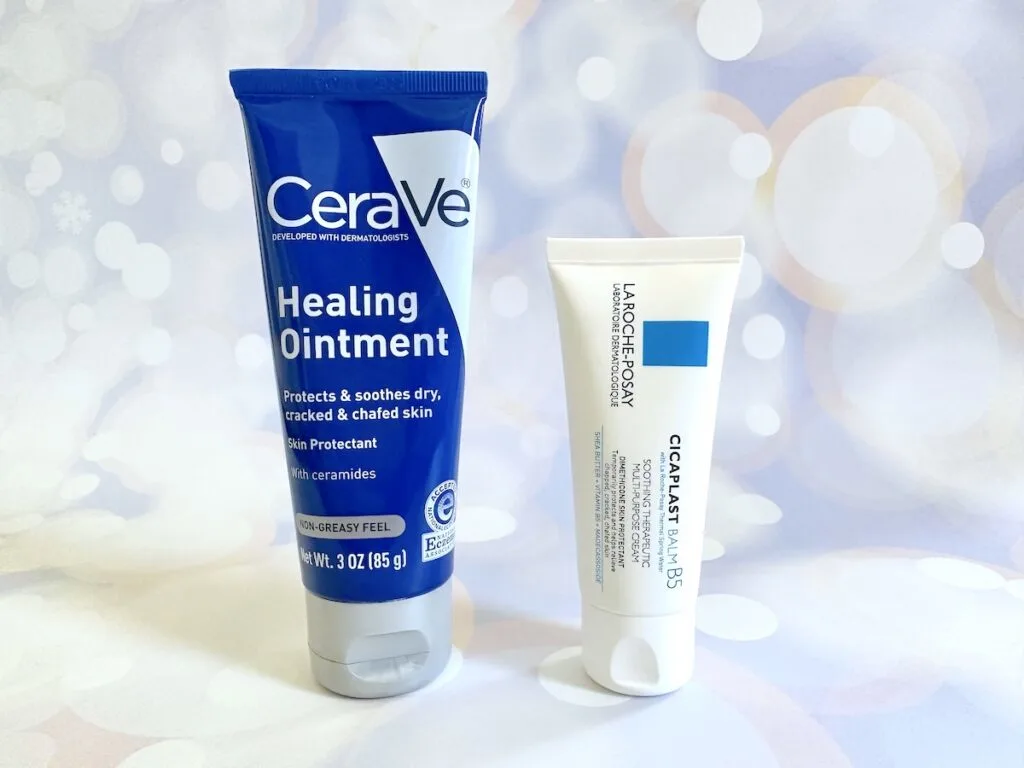
CeraVe Healing Ointment
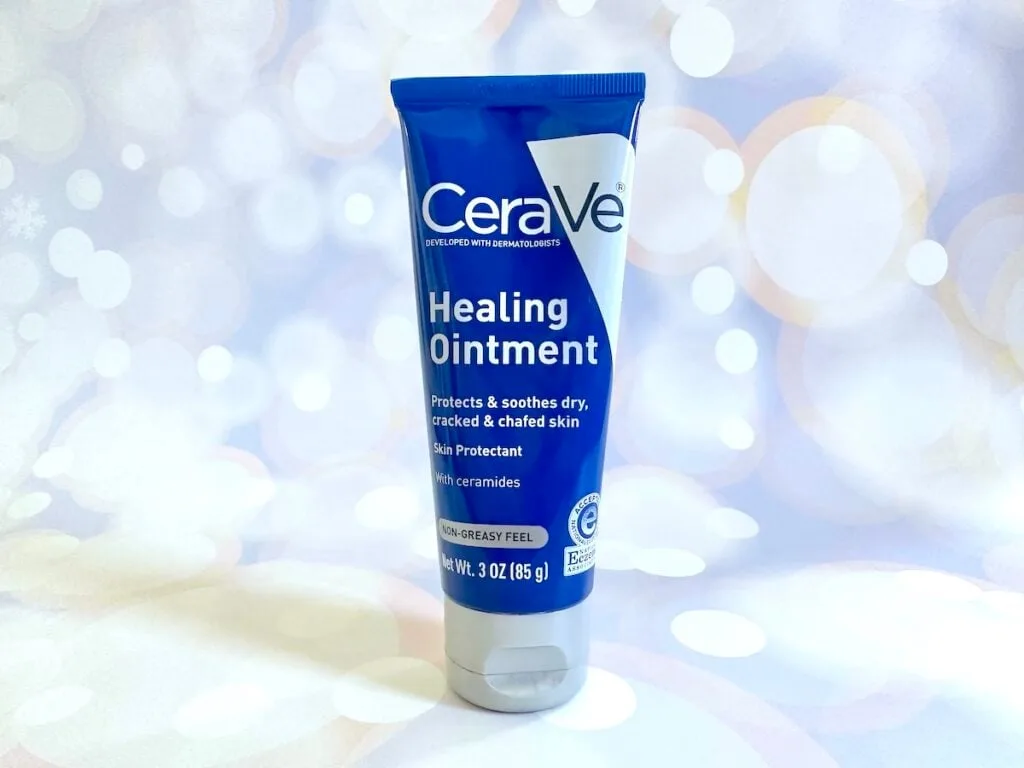
CeraVe Healing Ointment is a rich ointment formulated with petrolatum at 46.5%, which makes it so thick.
This balm also contains mineral oil, an emollient that forms a protective barrier and helps your skin retain moisture.
Ceramide NP, Ceramide AP, and Ceramide EOP seal in moisture and help restore and maintain the skin’s protective barrier, and hydrolyzed hyaluronic acid hydrates the skin.
The amino acid proline and cholesterol, which are skin-identical ingredients, help the skin retain moisture.
Vitamin E offers protective antioxidant benefits, and panthenol, also known as pro-vitamin B5, helps soothe the skin and provides moisture.
Dimethicone is a skin protectant that helps prevent water loss and moisturizes the skin.
CeraVe Healing Ointment is occlusive, which means it forms a protective film on the skin that locks in moisture.
The ointment is ideal for cracked, dry, and chafed skin since it restores its protective barrier to heal dryness.
This balm ointment avoids irritation as it is lanolin-free and fragrance-free. It is suitable for all skin types and is non-greasy and non-comedogenic, so it won’t clog your pores.
It’s also accepted by the National Eczema Association, so it’s suitable for eczema-prone skin.
You can even use this in a skincare slugging routine after cleansing and moisturizing.
La Roche-Posay Cicaplast Balm B5
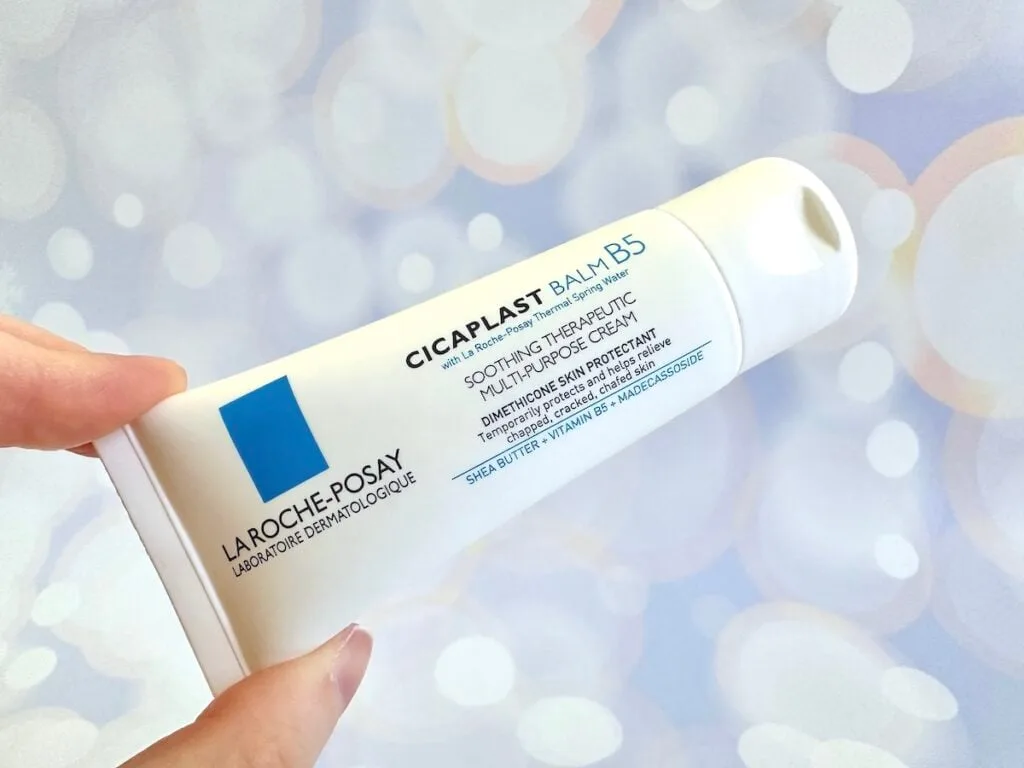
La Roche-Posay Cicaplast Balm B5 is a multipurpose face cream formulated for dry, cracked, chapped, and chafed skin. This soothing balm protects delicate skin while hydrating and soothing the skin.
This non-greasy cream contains madecassoside derived from Centella asiatica to soothe and restore the skin and panthenol to moisturize and calm the skin.
The cream also contains 1% dimethicone, a type of silicone that protects the skin and forms a barrier to prevent water loss.
The formula includes sustainably sourced shea butter to replenish your skin and lock in moisture for long-lasting hydration.
La Roche-Posay Thermal Spring Water contains minerals, trace elements, and antioxidants to soothe and protect the skin. Vitamin E offers antioxidant protection, while panthenol soothes the skin.
The semi-occlusive balm allows your skin to breathe while forming a protective layer on your skin.
The thick, rich formula is perfect for dry patches on the face, body, and lips.
Ideal for those with a sensitive or dry or very dry skin type, this calming balm is suitable for babies one week and older and is excellent for diaper rash.
It’s also accepted by the National Eczema Association.
CeraVe vs La Roche-Posay Ointment/Balm Similarities & Differences

| Similarities | Differences |
|---|---|
| ✅ Ideal for dry, cracked, and chafed skin | ✅ CeraVe => ointment texture; La Roche-Posay => rich cream texture |
| ✅ Contain dimethicone, vitamin E, and panthenol | ✅ CeraVe contains petrolatum, three essential ceramides, mineral oil, proline, and cholesterol |
| ✅ Fragrance-free | ✅ La Roche-Posay contains shea butter, madecassoside, and La Roche-Posay Prebiotic Thermal Water |
| ✅ Suitable for sensitive skin | |
| ✅ Non-comedogenic | |
| ✅ Accepted by the National Eczema Association |
Both products are ideal for dry, cracked, and chafed skin. CeraVe has an ointment texture, while La Roche-Posay has a thick cream texture.
Both contain dimethicone and vitamin E for skin protection and panthenol for its soothing, moisturizing benefits.
Both are good for skin sensitivity, non-comedogenic, and accepted by the National Eczema Association.
CeraVe also contains petrolatum, three essential ceramides, mineral oil, proline, cholesterol, and hyaluronic acid.
La Roche-Posay also contains shea butter, soothing madecassoside, and La Roche-Posay Thermal Spring Water.
CeraVe Hydrating Mineral Sunscreen SPF 30 Face Sheer Tint vs La Roche-Posay Anthelios Tinted Sunscreen SPF 50

CeraVe Hydrating Mineral Sunscreen SPF 30 Face Sheer Tint

CeraVe Hydrating Mineral Sunscreen SPF 30 Face Sheer Tint is a 100% mineral sunscreen formulated with titanium dioxide and zinc oxide that offers broad-spectrum SPF 30 UVA/UVB sun protection.
The sunscreen contains 10% zinc oxide and 5.5% titanium dioxide.
It is tinted to offset any white cast that can come along with mineral filters and is designed to work with all skin tones.
This physical sunscreen also contains three moisturizing ceramides, hydrating hyaluronic acid (sodium hyaluronate), and brightening and smoothing niacinamide. Vitamin E offers antioxidant benefits.
The sheer natural finish is very moisturizing, which is a nice change from some other mineral sunscreens, which tend to try out your skin.
This fragrance-free CeraVe sunscreen is non-greasy, non-comedogenic, and suitable for sensitive skin.
Related Post: Best Drugstore Mineral Sunscreens
La Roche-Posay Anthelios Tinted Sunscreen SPF 50
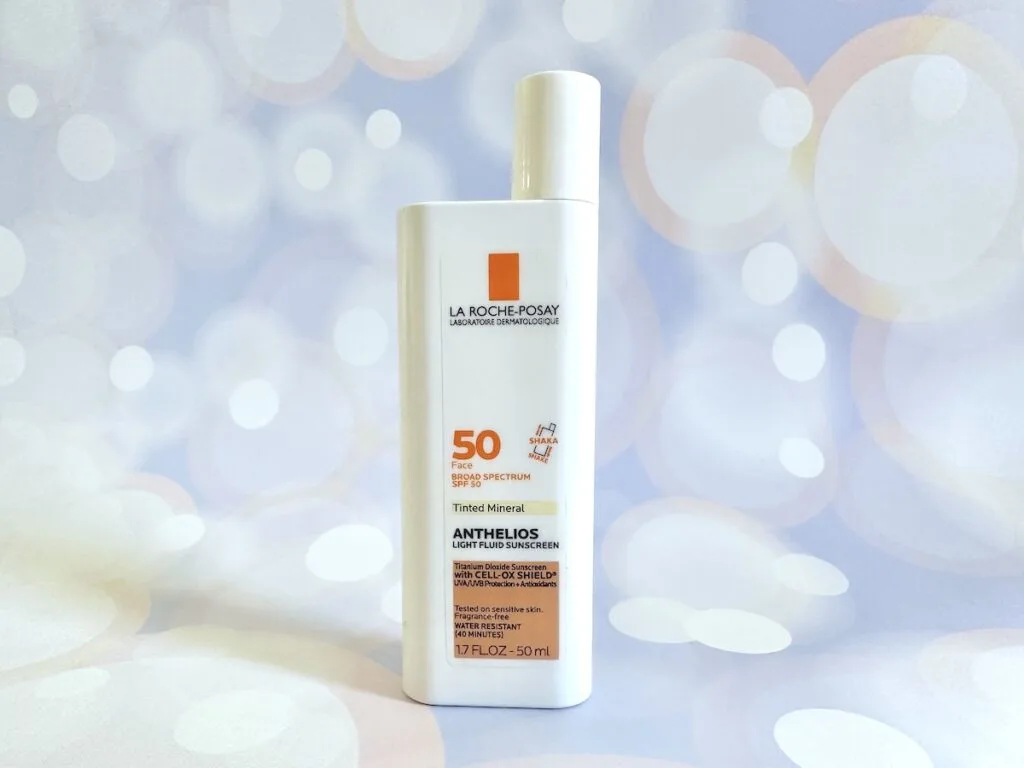
La Roche-Posay Anthelios Tinted Sunscreen SPF 50 is a 100% mineral-tinted facial sunscreen formulated for sensitive skin.
It contains 11% titanium dioxide to provide broad-spectrum UVA/UVB protection.
This tinted sunscreen uses La Roche-Posay’s Cell-Ox Shield Technology, an antioxidant technology that combines photostable UVA/UVB filters with antioxidant protection in the form of Senna Alata.
Senna Alata is a tropical leaf extract that helps protect skin cells from free radical damage caused by sun exposure.
The sunscreen also contains mineral-rich La Roche-Posay Thermal Spring Water and antioxidant vitamin E. Silica absorbs excess oil and creates a soft focus effect.
This sunscreen has an ultra-lightweight texture, absorbs quickly, is non-greasy, and leaves a matte finish.
The oil-free sunscreen is non-comedogenic, fragrance-free, and water-resistant for 40 minutes.
NOTE: The tint is a little dark for my light skin tone, so I think it would work better for medium/darker complexions.
CeraVe vs La Roche-Posay Sunscreen Similarities & Differences
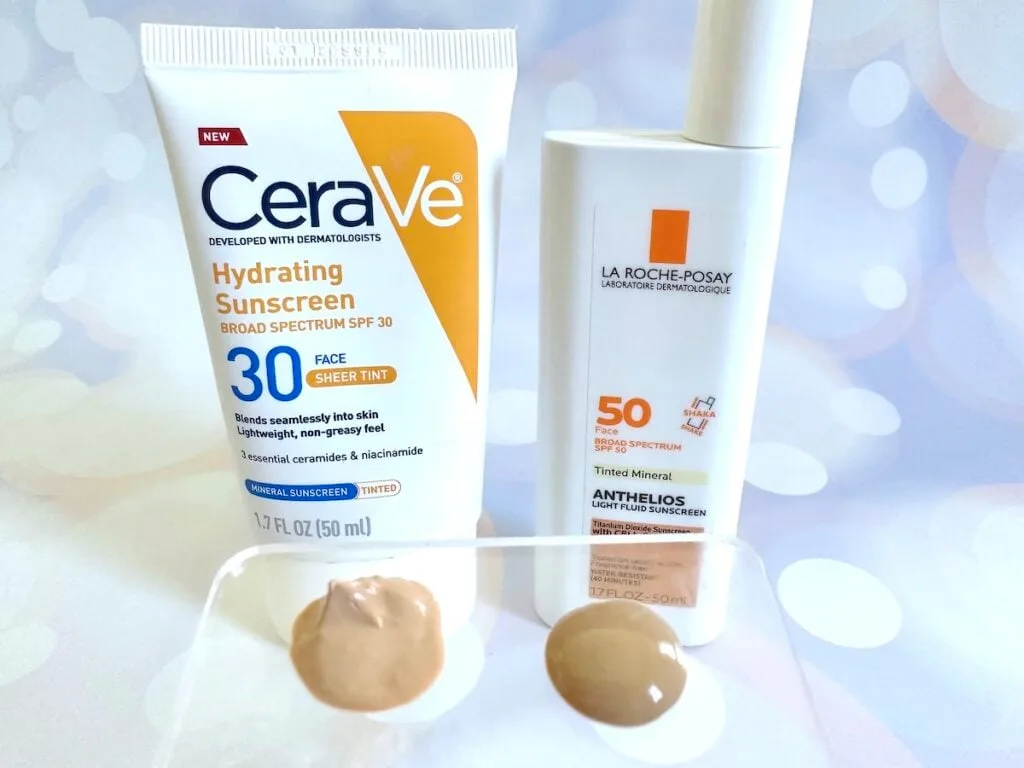
| Similarities | Differences |
|---|---|
| ✅ Contain 100% mineral filters | ✅ CeraVe has a natural finish; La Roche-Posay has a matte finish |
| ✅ Tinted | ✅ CeraVe => 10% zinc oxide and 5.5% titanium dioxide; La Roche-Posay => 11% titanium dioxide |
| ✅ Contain vitamin E | ✅ CeraVe contains three essential ceramides, hyaluronic acid, and niacinamide |
| ✅ Fragrance-free | ✅ La Roche-Posay contains shea butter, madecassoside, La Roche-Posay Prebiotic Thermal Water, Cell-Ox Shield Technology (antioxidant protection), and silica |
| ✅ Non-comedogenic | ✅ La Roche-Posay has a darker tint |
| ✅ Suitable for sensitive skin |
Both sunscreens contain 100% mineral filters and are tinted, although La Roche-Posay has a darker tint.
Both contain the antioxidant vitamin E.
Both are fragrance-free, non-comedogenic, and suitable for sensitive skin.
CeraVe contains 10% zinc oxide and 5.5% titanium dioxide, while La Roche-Posay contains 11% titanium dioxide. CeraVe has better UVA protection since zinc oxide provides better protection against UVA rays.
CeraVe has a moisturizing natural finish, better suited to drier skin types, while La Roche-Posay has a matte finish.
CeraVe contains hyaluronic acid, niacinamide, and three essential ceramides.
La Roche-Posay contains soothing La Roche-Posay Thermal Spring Water and proprietary antioxidant protection in the form of their Cell-Ox Shield Technology. La Roche-Posay also contains oil-absorbing silica.
Related Post: La Roche-Posay Sunscreen Review
About CeraVe
CeraVe was founded in 2005 when experts noticed that skin conditions like dry skin, acne, eczema, and psoriasis all share the same quality – a compromised skin barrier.
CeraVe set out to develop products with dermatologists that contain three essential ceramides and a patented delivery system (MVE Technology) to replenish the skin’s natural protective moisture barrier.
CeraVe uses a unique combination of three skin-identical ceramides in their skin care products: Ceramide NP, Ceramide AP, and Ceramide EOP. These ceramides support the skin barrier and help the skin retain moisture, making their products perfect for dry skin.
CeraVe’s products address skin concerns like acne, eczema, psoriasis, aging, and itchy and dry skin.
About La Roche-Posay
La Roche-Posay is a French pharmacy brand that has been around for over 40 years, as it was founded in 1975.
The brand is known for its commitment to research and innovation, works closely with dermatologists, and its mission is a better life for sensitive skin.
La Roche-Posay’s signature ingredient is La Roche-Posay Thermal Spring Water, which helps to soothe and replenish the skin.
La Roche-Posay features a range of ingredients in its dermatological skincare lines that target aging (Hyalu B5), sun-sensitive (Anthelios), oily acne-prone (Effaclar), and sensitive allergy-prone skin (Toleriane).
The Bottom Line
Is La Roche Posay better than Cerave? Or is CeraVe the better brand? Each brand has its own strengths.
CeraVe is excellent for treating dry skin and restoring the skin’s protective barrier, while La Roche-Posay’s products are ideal for sensitive skin.
CeraVe and La Roche-Posay offer a complete range of skin care solutions formulated with high-quality ingredients.
While La Roche-Posay is more expensive than CeraVe, both brands are affordable and effective.
Thanks for reading!
Read Next: Cetaphil Daily Facial Cleanser vs Gentle Skin Cleanser


marjorie
Sunday 4th of June 2023
Thank you so much for doing this comparison Sarah! Love and truly appreciate your work :)
Sarah
Sunday 4th of June 2023
That's so nice of you to say! Thank you so much!!